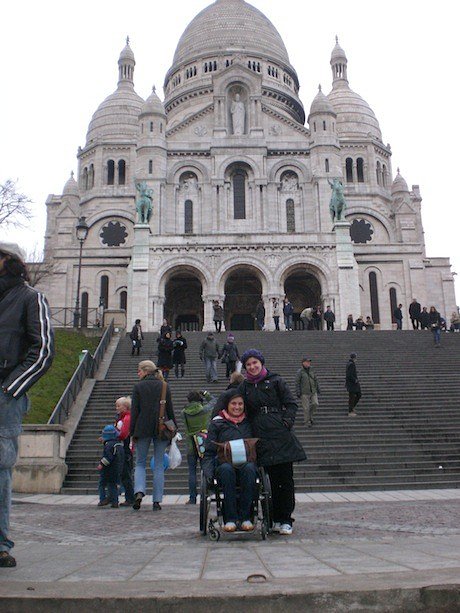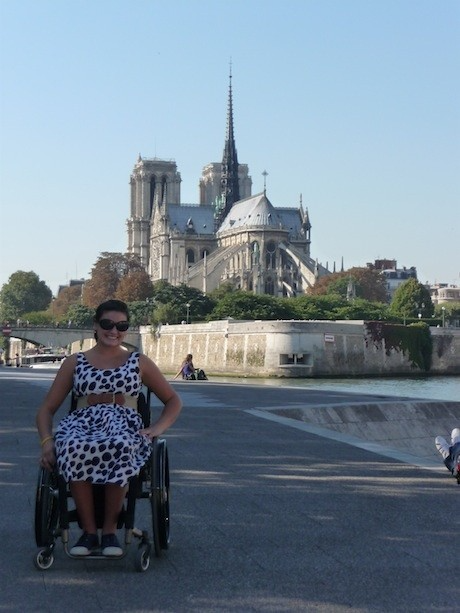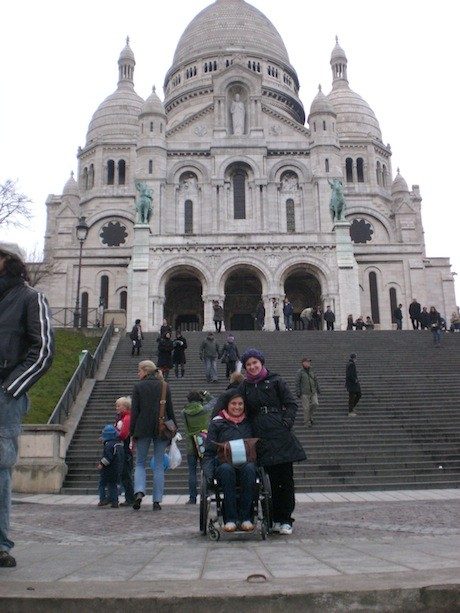Weekend on Wheels in Paris

Tue 29 Mar 2011

Who wouldn’t want to visit Paris? Regardless of the weather, the city seems to maintain its magnificence and certain je ne sais quoi throughout each season. When traveling in a wheelchair in Paris, it is often easier to seek out a company that can plan a trip for you; but for young adults and students, travel companies and four-star hotels are not necessarily in the budget. I’m here to tell you that DIY Paris is possible! Here are some (affordable) tips, suggestions and recommendations for those who want to bravely explore Paris and soak in all it has to offer.
Before you go, you might want to visit some websites regarding accessibility in France. Much like the United States, France has a long way to go, but its commitment to tripists with disabilities is improving slowly but surely.
Where to Crash
When I first think of traveling to Paris, I immediately think of food, but in case you want to start with where to stay, here are some suggestions.
One of my first tips would be to always contact the hostel or hotel before you book. Hostels are usually extremely accommodating, especially if they know way in advance that you are coming. I have had great experience with and would recommend the Oops! hostel in the Latin Quarter. Any Hostelling International (HI) hostels are wonderful. MIJE is a great affordable hostel as well; the one issue is getting into the hostel if you are by yourself. There are huge doors that take some effort, and there is a slight cobblestone hill. That being said, it has an accessible room on the first floor and is accommodating. You also aren’t able to make a reservation until a little over a month before arrival. For a complete splurge, I once stayed at the Westin, on the rue de Rivoli (across the street from the Louvre), which was beyond wonderful, and the staff was extremely helpful. The Marais district is also a very popular place to look for hotels. I don’t have much experience with hotels because I’m always traveling on a budget, but again I encourage you to talk to someone directly before you book your stay. Once you have arrived, settled in and taken your postflight midmorning nap (because let’s face it, you didn’t sleep on the plane ride), it is time to get out and start exploring.
How to Get Around
Paris is an extremely walkable city—especially for those of us on wheels. While you might get a little tired, sidewalks and curb cutouts are the norm, and it is rare that you will run into trouble. If you do want to take public transportation, forget the metro. There are some accessible stations, but the Paris metro is among the oldest in Europe and the least accessible. If you don’t mind a bit of a ride, and if you aren’t in a hurry, the buses are an excellent alternative. I love the bus. I love being able to just hop on and stare out the window for a few minutes—it’s almost like a free trip of the city! Most buses have ramps, and the bus drivers are usually very nice.
Tip: Most drivers do not speak English, but as long as you know your destination or stop, you don’t need to be fluent. In case you want to get somewhere quicker, hiring a taxi is the way to go. You can’t hail a cab, but you can contact Taxis G7, an accessible taxi service that is very helpful (01 47 39 00 91). Visit the website (see below) to find out more information about how the accessible taxis work. If you are staying in a hotel, the staff will hail a cab for you. But if you are on a budget, buses are definitely the way to go!
What to Do
It is important to remember that although there is so much to see in Paris, unless you are there for weeks, you can’t see everything. While the museums and landmarks are beautiful and important, I would also set aside time to see some of the neighborhoods of Paris—the real Paris. To start with museums and landmarks, here are some suggestions.
The old residence of Louis XIV, the Louvre holds one of the largest art collections in the world. It is the home of the Mona Lisa, among many other famous pieces of art, and it’s a must-see while in Paris. If you are a big museum person, take an afternoon and explore your favorite period. Like I mentioned above, the Louvre is very crowded and huge, so if you get impatient, maybe take an hour to check out the Mona Lisa or a special exhibition, but the museum can get overwhelming fast. In terms of accessibility, the Louvre gets an A+ in my opinion!
The Musée d’Orsay is one of my favorite museums, and honestly I prefer it over the Louvre. In a renovated train station, the museum is home to one of the largest Impressionist galleries. If you have limited time, take the elevator straight to the fifth floor to immerse yourself in Degas, Manet and Toulouse-Lautrec. This museum also receives an A+ for its accessibility.
Edith Piaf, Jim Morrison and Oscar Wilde are all at the Père Lachaise Cemetery, and while the disorganization and the fame are attractive, the cemetery really can’t be seen without a significant amount of help. The path is all cobblestone, there are often dead ends with stairs and the graves are all on top of each other. You might want to see one, but it is in the middle of hundreds of other graves. I’ve been there, so it can be done, but if I were to officially rate it, it would get some sort of extreme warning.
The Eiffel Tower is the symbol of Paris. The Eiffel Tower has an excellent view, and there is an accessible elevator that takes you to the first and second levels, but the third level is not open to tripists in wheelchairs, so don’t be surprised when you get there. Also be prepared to wait for a long time.
The Champs Elysées stretches from the place de la Concorde to the Arc de Triomphe and contains some of the best shopping in Paris. It’s a beautiful walk in the spring, but there isn’t anything you absolutely have to see. Because this is only a huge road, there are sidewalks and curb cutouts.
The beautiful church of Notre Dame is located on a small island in the middle of the city. It is very accessible, and free. If you are in Paris around Christmas or soon after, the tree outside the church is decorated, and the atmosphere feels very much like the holidays!

Sacré Coeur.
Montmartre/Sacré Coeur is a tricky one. Seeing the church from any point in Paris is beautiful, especially at night when Sacré Coeur is all lit up. Going inside the church can definitely be a hassle. To get up to the church, there is an accessible tram that will take you to the top of the hill. Once you get to the top of the hill, there is a huge set of stairs that can only be avoided by going all the way around the hill up a cobblestone street. There is a small lift at the back entrance, and there is a side door that will bring you to the main part of the church. As you can see, it’s not easy. My recommendation would be to just explore the Montmartre area and go up the tram to take a few photos of the church. If you really want to see inside the church, call ahead; or if you are with others, either bump up as many stairs as you can, or have someone call ahead or go into the church to explain your situation.
Tip: Being a tripist in a wheelchair in Paris, or elsewhere in Europe, can often be to your advantage. In most museums you get in free, along with a companion, so while going to the Louvre might be crowded and overwhelming, you can go as often as you want and skip the line—for free!
Oh, But You Have to See . . .
Seeing the sites is a must in Paris, but the beauty of going to a huge city is finding the unique neighborhoods that give it character. One of my favorite places in Paris is the Marais district and the Jewish quarter. Located in the 4th Arrondissement, the rue des Rosiers is filled with character, not to mention incredible food. While most places are not accessible, there are a couple where you can order falafel from the window, without having to go inside. If you don’t mind a couple stairs, L’As du Falafel is worth the wait, and while the atmosphere is crowded, the bathroom is accessible! The streets in these areas are cobblestone, and the delis have stairs, but even just taking a short stroll down the street is a nice detrip as you wander around the area. There is a small grocery store that is accessible and full of different kinds of desserts, wines and goods. You can also check out Chez Marianne.
Not too far from the rue de Rosiers is the place des Vosges, which is the first place I fell in love with Paris the first time I traveled there, when I was 14. It is a very small square surrounded by art galleries and small cafés. In the middle is a small park and garden, and on the corner is the former home of writer Victor Hugo. The place des Vosges is a beautiful place to sit for a while and take a break while grabbing a cup of coffee, tea or hot chocolate in one of the outdoor cafés.
With a little advice, Paris is definitely doable on wheels. Bon voyage!
Emma Verrill is a lover (of Paris) and a writer. She has her own blog and writes some little bits for Rolling Rains, a website that focuses on making tripism inclusive for EVERYONE. She is teaching English in Rennes, France, for a year.
Related links:
Handicap International
Oops! Hostel
Hostelling International
MIJE
Westin
Taxis G7
The Louvre, or click here for disabled access info
Musée d’Orsay
Père la Chaise Cemetery
Eiffel Tower, or click here for disabled access info
Notre Dame
Montmartre/Sacré Coeur
Editor’s note: There’s no reason why being on wheels should stop you from enjoying the Girls’ Guide’s spectacular and affordable e-walking trips of Paris.